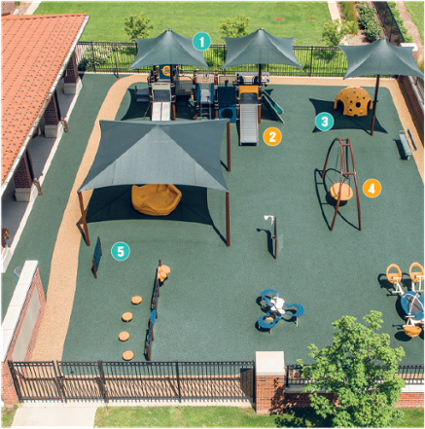Outdoor Learning Space
To Aid Treatment, Research of Children's Communication Challenges
Story by Greg McClure, photos by Charles Jischke
Above: The Bob L. and Joyce Beery Miles.
The new Bob L. and Joyce Beery Miles Outdoor Learning Space at Purdue’s Lyles-Porter Hall is designed to enhance treatment and research of children’s communication, sensory and motor skills as they play.
“Play is an important part of a child’s development. When you’re engaging children with communication issues, it’s even more important,” says Keith Kluender, professor and head of the Department of Speech, Language, and Hearing Sciences. “Like communication, real play is not done alone. This area will help students and staff, and be an important part of improving communication.”
The space looks like an inviting playground, but the equipment was carefully selected to fulfill the needs of the children and researchers. Frequently, children with communication, sensory and motor skills issues will play alone, but the space was designed to encourage interaction.
“The area incentivizes children to invite other children to use it and make it fully operative,” says Emily Studebaker, clinical assistant professor of speech, language, and hearing sciences. “They have a need for imaginative play and peer interactions. The learning space will provide opportunities for social development.”
Every station is designed to accomplish several purposes.
“Each piece of equipment meets multiple needs,” says Hope Gulker, clinical associate professor of speech, language, and hearing sciences. “All children learn best in active settings, and the design offers opportunity for vigorous, self-directed play in a safe environment. Many children with communication challenges require motivation and practice to use and improve social skills, and several structures place peers and adult play partners face-to-face to facilitate relationship building and conversation.”
The area has a soft, smooth, almost bouncy ground surfacing, which allows all children access, and makes it less likely for them to be hurt if they fall. It is fenced and also is shaded to prevent sun or heat exposure. At least 25 children will use the space daily, says Claudia Mornout, director of clinical education in speech-language pathology.
“The space provides ways to investigate and treat children’s communication skills in ways not possible within traditional therapy rooms and classrooms,” she says. “It’s also a teaching opportunity for our students. They’re responsible for assessing what each child needs and finding the right equipment.”
The outdoor learning area is made possible by a gift from alumni Bob and Joyce Miles. Bob earned a civil engineering degree in 1963 and Joyce received a degree in family and consumer sciences in 1965. Joyce worked for 30 years as a teacher and supervisor in home economic sciences in Jacksonville, Florida, public schools.

“Our hopes are that this outdoor learning area enhances the experiences of the children it serves,” Joyce Miles says. “An unintended benefit we are hoping for is that the area becomes a window into what goes on in Lyles-Porter Hall. Seeing the children in the outdoor learning space invites others to wonder why they are there.”
Kluender says Susan Erler, former director of Northwestern University’s Doctor of Audiology Program, also played a key role in making the space a reality. She served on the SLHS Advisory Council and led the fundraising campaign for the space. In addition, Susan and Bryan Erler were among the first to contribute to the campaign.
“Susan’s passion is how this outdoor learning space moves the research ahead,” he says. “If we can use this space to better understand communication disorders and develop new treatments for those disorders, that would be big.”
Climbing Structure: Exercises large muscles and requires children to master complex plans. The marble panel provides a fun tactile experience.
Roller Slide: Provides sensory input, and its surface helps avoid static electricity buildup, which allows children with cochlear implants to use it.
Dome: Up to five children at once climb, hide and chat through the openings and holes. An overwhelmed child may find sanctuary inside the dome, providing much-needed protection and peace.
Oodle Swing: Four children may swing together, socializing and cooperating. Provides vestibular stimulation, which calms and organizes the sensory system.
Communication Board: Removable pictures represent playground equipment options. Empowers nonverbal and/or language-delayed children to effectively communicate their choices to adults.
Source: Hope Gulker
More Life 360 Stories
Alumni
- Outdoor Learning Space
- A Fond Farewell
- Lessons From Those Who Live the Longest
- HTM Professor Leads Global Trend in Advancing Sustainable Tourism
- Convenience, Health Fuel Growth in Boxed-Food Delivery Industry
- Defining the Field for 80 Years
- Compassion Comes Full Circle
- Purdue Memorial Union Inspired Houston-Based Restaurateur
- Where are they now?
Faculty
- Outdoor Learning Space
- A Fond Farewell
- Tips for Aging Well
- Developing a Child Care Curriculum for the Department of Defense
- Not to be Forgotten
- HTM Professor Leads Global Trend in Advancing Sustainable Tourism
- Convenience, Health Fuel Growth in Boxed-Food Delivery Industry
- Better Beginnings
- Defining the Field for 80 Years
- MRI Facility Opening New Avenues of Research






